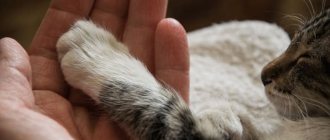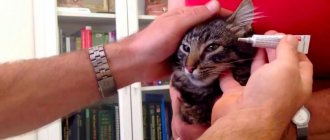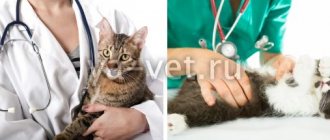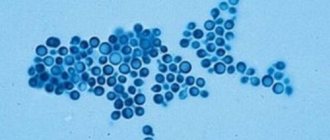Fungus in a cat is a generalized definition of diseases of the skin and internal organs caused by the activity of pathogenic microorganisms dermatomycetes (dermatophytes) on the animal’s body. Parasitizing in the upper layers of the skin, fungi cause peeling of the epidermis, dullness and hair loss, and an unpleasant odor. Lack of timely treatment leads to non-healing itchy wounds, weight loss, and a general decrease in the body's defenses. Ringworm is extremely contagious and can be transmitted to humans, therefore, if you suspect your pet has an infection, you should immediately show the animal to a specialist, identify the pathogen and begin treatment.
Main types of fungal infections
All fungal diseases in cats are divided into 2 large groups.
- Parasitic on mucous membranes and skin.
- Systemic – affecting systems and organs. Fungal damage to the central nervous system may even occur. They are extremely rare in cats. More often they affect the body of dogs and can take their lives.
In this condition, the skin of a sick cat turns red, areas of baldness and scratching appear on it. Treatment of the disease should begin immediately after its detection.
Lichen is the common name for dermatophytosis, trichophytosis, microsporia in animals
Ringworm (dermatophytosis, trichophytosis, microsporia) is a fungal skin disease of cats and dogs. The disease is contagious to people and other animals! The disease is caused by fungi of the genus Microsporum, Epidermophyton, Trichophyton . Even with long-term storage in the environment, these mushrooms remain dangerous for a long time due to their spores. The spores can survive in the environment for several months to several years. The incubation period (the period from infection to the onset of skin signs) is from 4 days to 4 weeks.
Fungus in the ears
For a cat, this procedure is unpleasant, although not painful, and therefore, during it, considerable effort is required from the owner to restrain his raging pet.
If the owners have discovered a fungus in their cat or they suspect it, they should not self-medicate, but it is important to take the pet to a good veterinary clinic as soon as possible.
Diagnostic methods
Diagnosis of the disease is carried out only in a veterinary clinic. You should not listen to friends’ advice about what remedy to take to get rid of fungus, since many fungi are dangerous to humans, and the lack of timely and adequate therapy will have an extremely negative impact on the owner.
Only a specialist can determine the necessary treatment for fungus in cats. In order to identify the type of fungus that has affected the cat, the veterinarian takes a skin scraping at the site of the lesion. What kind of infection is occurring is determined very quickly, after which the right medicine is selected.
When a veterinary clinic has a powerful laboratory, they not only determine the type of fungus, but also determine what type of drugs it will be most sensitive to. Thanks to this, it is possible to carry out therapy with the most effective antifungal drugs.
Routes of infection
The main carriers of pathogenic microscopic fungi are rodents and stray animals. The following factors contribute to their spread:
- high humidity;
- unsanitary living conditions;
- crowded keeping of pets.
Cats kept at home without walking can become infected with spores carried on the owners' clothes and shoes.
Reducing the level of resistance can be facilitated by:
- helminthiases;
- viral and bacterial infections;
- unbalanced diet;
- injuries;
- hypothermia or heatstroke;
- dysfunction of the endocrine glands;
- pregnancy and lactation period.
Interesting! Not many people know that frequent conflicts in the family, divorce, long-term departure or depression of one of the owners has a very detrimental effect on the pet’s psyche, affecting its immunity and general health.
The presence of open wounds, abrasions, ectoparasite bites and other mechanical damage on the animal’s skin increases the risk of infection by pathogenic fungi.
What can lead to the formation of fungus
If we consider the picture as a whole, we can say that the appearance of nail fungus in cats (and not only it) occurs when the pet has physical contact with other representatives of its species.
In this case, even those cats that lead a domestic lifestyle are not insured, as they can pick up pathogens from the outdoor shoes and clothes of their owners.
This is especially true in rainy weather or in a house where there is a constant humid environment. In addition, you should be wary of minor injuries, diaper rash, etc.
The following factors can lead to the appearance of fungus:
- A young and fragile body;
- The period of lambing in a cat, when the body’s defense systems weaken;
- Decreased immunity due to the activity of a dangerous virus;
- Poor feeding;
- Carrying out immunosuppressive therapy;
- The influence of other serious diseases such as diabetes.
In some cases, diseases of this type may be asymptomatic, so they can only be detected after the hosts themselves have become infected. Very often children become the first carriers, as they most often play with pets.
Causative agents of ringworm
Symptoms of trichophytosis
The cat has:
- apathy;
- refusal of food;
- noticeable weight loss;
- nervous disorders.
- the fur becomes dull, changes color and falls out easily.
Symptoms of microsporia
Important! If the cat is fluffy, then areas of baldness are almost impossible to notice. The presence of the disease in this case is indicated by dandruff and itching.
Unlike trichophytosis, inflammation of the epidermis in microsporia is mild. An atypical form of microsporia is pustular dermatitis, in which hair loss does not occur, but papules and pustules form on the animal’s body.
When the disease becomes chronic, cats experience a subclinical course, which is characterized by the presence of areas with broken hairs covered with white dusty mycelium of the fungus.
Treatment
The basic principles of treating ringworm are to use:
- therapeutic and prophylactic vaccine;
- external antifungal agents;
- emollients;
- antiseptic ointments;
- oral antibiotics (in the presence of purulent dermatitis).
Important! This product may cause chemical burns. Therefore, it is necessary to apply it to lichen spots using an ear stick very carefully, touching the edges of healthy skin by 1-2 mm.
Symptoms of pathology
Symptoms of ringworm appear 4-6 weeks after the patient becomes infected. A red spot appears on a smooth area of skin of a child or adult. It rises above the surface and has smooth boundaries. Over time, the size of the lesion increases. The surface becomes covered with nodules, blisters and scabs. The spots develop into rings that can intersect or merge with each other. The diameter of skin formations ranges from 5 to 30 millimeters.
Signs of ringworm include an acute inflammatory reaction. It often develops in children and girls. The lesions begin to peel off intensively. Patients suffering from dermatitis do not immediately identify symptoms of microsporia. Areas of active fungal growth may appear as inflammatory skin lesions.
A common manifestation of ringworm in a child is damage to the scalp. This symptom affects patients aged 5-12 years. Older children experience changes in the chemical composition of sebum. Its elements become dangerous for the microsporia pathogen.
The suppurative type of ringworm is characterized by the appearance of soft nodules on the patient’s skin. The nodes are dotted with numerous abscesses. When they are compressed, purulent contents are released.
Are you experiencing symptoms of ringworm?
Only a doctor can accurately diagnose the disease. Don't delay your consultation - call
Causative agent of aspergillosis
Fungal spores, falling on the mucous membranes of the nasal cavity or conjunctiva, penetrate the epithelial barrier into the tissue, destroy surrounding cells and suppress the action of phagocytes. Depending on the location, there are 2 forms of pathology:
- sinonasal;
- sinoorbital.
I recommend: Distemper (panleukopenia) in cats: symptoms and treatment
Symptoms of sinonasal aspergillosis (SNA)44
This form is characterized by general signs of rhinitis:
- sneezing;
- labored breathing;
- serous or purulent nasal discharge.
Further proliferation of pathogenic fungi leads to the formation of granulomas and protrusion of overgrown tissues from the nostrils. In especially severe cases, melting of the bones of the upper jaw and nasal septum is observed.
Symptoms of sino-orbital aspergillosis (SOA)44
Since in most cats this form of the disease begins with the appearance of nasal discharge, it is hypothesized that SOA is a consequence of SNA after lysis of the orbital plate.
Signs of the sinoorbital form are:
- unilateral protrusion of the eyeball (exophthalmos);
- prolapse of the third eyelid;
- keratitis;
- conjunctival hyperemia.
Treatment
Veterinary experts give a cautious prognosis regarding the outcome of aspergillosis in cats.
SNA treatment is carried out in a clinical setting and includes:
- use of oral antifungal drugs (Fluconazole, Itraconazole and others);
- intranasal administration of Clotrimazole under general anesthesia;
- intravenous administration of Clotrimazole.
Important! If necessary, surgical excision of the affected tissue is performed.
Treatment of SOA is more labor intensive, and in most cases antifungal therapy is combined with surgery.
Can a person or another pet get shingles?
It is important to remember that dermatophytosis is a contagious disease to other pets and humans. However, infectiousness also depends on the immunity of the animal or person in contact with the sick person.
The incubation period ranges from one to three weeks, and the manifestation of clinical signs depends on risk factors.
Main risk factors:
- age (young and older dogs and cats get sick more often);
- damaged skin (presence of abrasions and scratches);
- concomitant diseases (for example, immunodeficiency in cats);
- stress.
Long-haired cats are often carriers of dermatophytosis type M. canis. About 10–90% of cats are so-called asymptomatic carriers (without showing clinical signs). Up to 90% of cases of human dermatophytosis are caused by the same type of M. canis and the source of infection is cats.
But a person (or pet) can also become infected from a dog. Yorkies and hunting breeds are predisposed to dermatophytosis.
Infection occurs when fungal hyphae attach to a weakened organism. Subsequently, they descend into the hair follicles, in which the fungus forms spores. Subsequently, clinical symptoms appear and the pet can infect the person or animals with which it has been in contact, especially if their immunity is weakened.
In cats, the muzzle area, ears, and forelimbs are often affected. In dogs - head, neck, limbs.
Causative agent of cryptococcosis
Carriers of the yeast-like pathogenic fungi Cryptococcus neoformans are wild and domestic birds. Cats become infected by inhaling spores of the pathogen when sniffing droppings, bedding or other objects that have previously been in contact with carriers.
It is believed that a person cannot become infected with cryptococcosis from their pet. But experts advise following hygiene rules, since the potential possibility cannot be completely ruled out.
Symptoms
There are 2 forms of the disease depending on the location of the pathological process.
Treatment
Therapy is reduced to the use of oral and external antifungal drugs. It is advisable to additionally treat foci of purulent inflammation with antibacterial ointments or sprays.
Organs susceptible to fungal infection
Fungus in cats can affect various organs, but there are general symptoms of fungus in cats , characteristic of all types of fungal infections:
- Coughing;
- depressed state;
- lack of appetite;
- prolonged scratching of a certain area;
- head shaking with ears back;
- dull coat and flaky skin.
Skin fungus
The skin is most susceptible to infection, including fungi, since the skin is the body's primary protective barrier.
Ear fungus
Ear fungus is considered one of the most famous infections, which, if not properly treated, can become chronic. The causes of the disease may be:
- Allergic reactions;
- various infectious diseases;
- unbalanced diet;
- congenital and hereditary pathologies;
- injuries and contact with the ear canals.
Symptoms of ear fungus include the following:
Claw fungus
The main cause of infection with claw fungus is a paw injury coupled with a weakened animal’s immune system.
Fungal eye diseases
The main symptoms of an eye infection include redness and swelling of the eyelids, and excessive lacrimation. In advanced cases, eyelashes may fall out, the area around the eyes will become bald, and purulent discharge may occur.
Blastomycosis
This fungus lives in soil that is contaminated with manure or bird droppings.
In addition to cats, people and dogs are also susceptible to this disease.
Very often, blastomycosis affects the respiratory system, skin, eyes and brain. This disease is very dangerous for humans. It is best treated with amphotericin B. In recent years, ketoconazole has been successfully used to treat blastomycosis. The main difficulty in treating this disease is the very high toxicity of these drugs. The likelihood of a cat infecting a person is not high, but it is better to take precautions. Contact with a sick cat is only possible while wearing protective gloves. There are also many known cases of human infection after a dog bite.
Visit the profile section of our Medical Examination forum or leave your feedback in the comments below. More opinions means more useful information, it will be useful to someone. If there are good and interesting
Treatment of fungus at home
Treatment of fungus in cats depends on the type of infection, the size of the affected area, and the general condition of the animal’s body.
General treatment methods include:
When treating fungus in cats at home, it is necessary to ensure that the animal does not lick recently lubricated areas or scratch them with its paws.
How to treat fungus in a cat at home
| Type of disease | Type of medicine | Name |
| skin fungus | tablets, powders | ketoconazole, moxicillin, terbinafine |
| ointments | clotrimazole, yam, tar ointment | |
| shampoos | nizoral, sebozol | |
| injections | microderm, polyvac, dermicocide | |
| ear fungus | drops | aurizon, oricin, posatex |
| pills | ketoconazole, griseofulvin | |
| ointments | Econazole, Sanoderm | |
| claw fungus | pills | terbinafine, fluconazole, lamisil |
| ointments | clotrimazole | |
| bath solution | enilconazole, chlorhexidine, thiabendazole | |
| eye fungus | drops | tsiprolet, chloramphenicol, leopard |
| ointments | tetracycline |
Traditional methods of treating fungus in cats
Onion juice is used to treat ear fungus using traditional medicine. Half the onion is grated, and the juice from the resulting mass is dripped into the ear infected with the fungus, 5 drops at night for 5 days.
I recommend: Pulmonary edema in cats: causes, symptoms, treatment
How is skin fungus treated?
Therapy for fungal diseases is long-term. It is unacceptable to end it without permission, deciding that the pet is completely healthy. Only a doctor can stop taking medications, since only tests can accurately determine whether the causative agent of the disease has been completely destroyed or whether it still partially remains in the tissues and the untreated animal will get sick again.
If the cat's damage is particularly severe, not only ointments and gels can be used, but also injections and droppers. Very often it is also prescribed to wash the pet using special medicated shampoos that contain miconazole.
The following drugs are usually prescribed to treat fungal infections::
- Sulfuric ointment;
- iodine;
- brilliant green;
- antifungal vaccines;
- clotrimazole ointment,
- potassium iodide.
In cases where the fungus is systemic and damages the liver, kidneys, lungs and nervous system, the use of the antibiotic amoxicillin is indicated. It can be administered by injection, which will be quite difficult for owners who do not know how to give injections due to the high density of the drug , or administered orally. Medicine for injections is purchased at a veterinary hospital, and for oral administration in a human pharmacy, according to a veterinarian’s prescription.
Parasitic diseases
Absolutely any cat can become a victim of parasites. Therefore, every owner needs to know how skin diseases manifest themselves, as well as how to treat fungus in cats.
Ringworm
The disease occurs as a result of infection with a special type of mold. Not only animals, but also people are susceptible to infection. Infection occurs through direct contact with a sick individual.
The most susceptible to the disease are weakened cats, young, elderly, and kittens.
Symptoms of ringworm:
To diagnose ringworm, the veterinarian performs a series of tests, based on which the type of pathogen is identified.
The initial stage of treatment consists of antifungal therapy. Bathing an infected cat is prohibited, since water procedures worsen the animal's condition.
If treatment with external drugs does not produce results, a course of injections is prescribed.
Scabies
Scabies is caused by microscopic mites that live deep in the skin. Once in the body, they begin to go deeper into the dermis, breaking through passages and laying eggs.
The medical name of the disease is notoedrosis. There is also a certain type of mite that lives in the ear canals. This disease is called otodectosis.
The symptoms of this disease are obvious:
- Severe, persistent itching;
- Cat anxiety;
- Hair loss;
- In areas of hair loss, you may notice inflammation, pustules and peeling.
Treatment of scabies involves the use of external ointments. A course of antiparasitic injections is also carried out. If the body is severely damaged and in a weakened state, it is necessary to adjust the animal’s diet.
Prevention of scabies and other parasitic diseases involves treating the animal with special anti-flea drops.
Dermatitis
As mentioned above, dermatitis can be:
- Traumatic;
- Medication;
- Infectious;
- Parasitic;
- There are also thermal and chemical.
- Skin lesions - purulent inflammation, blisters, discharge of ichor;
- Cracks in the skin, ulcers and peeling;
- Acne - black spots on the chin.
Treatment
The combination of drugs prescribed to the patient depends on the severity of damage to the skin, nail plates and hair follicles. Antifungal therapy may be local or general. In the first case, a child or adult needs to use creams and ointments that suppress the activity of the microsporia pathogen. Drugs in this group are not recommended for use by girls during pregnancy and lactation. Topical sprays are effective in treating large areas of ringworm. Modern formulations do not leave stains on the skin and are not absorbed into the fabric of clothing.
A severe inflammatory reaction is treated with a combination of antifungal and hormonal drugs. Patients will have to apply ointment applications to the affected areas. After this, the skin is treated with iodine solutions. The oral tablet intake schedule is formed by a dermatologist based on the clinical picture of the pathology.
The addition of a secondary infection to microsporia involves the use of drugs based on betamethasone, gentamicin or clotrimazole.
Allergic diseases
Allergies in cats happen quite often. It can be caused by absolutely any factor: from poor nutrition to harmful substances in the air.
Some cats have specific dietary preferences, eating certain fruits and vegetables, which can also trigger allergies.
Depending on the type of lesion, the veterinarian makes a final diagnosis and determines the type of parasite. Types of lesions:
Fungus in cats is a common disease, the occurrence of which does not depend on living conditions and diet. Any pet can become a victim of such an illness, so the owner needs to know what the fungus is and how to fight it.
Do you have any questions on the topic? Ask them in the comments.
Causes of dermatitis
It is impossible to become infected with Malassezia, since it is normally found on the skin of any healthy cat, so the cause of fungal dermatitis is caused by excessive, pathogenic proliferation of the fungus. A signal for its reproduction may be a decrease in the protective properties of the cat’s skin under the influence of various factors - allergies, decreased immunity, flea and tick bites, constant exposure to a humid environment (usually this is typical for stray cats that live in basements during the cold season), etc.
Is fungus dangerous for humans?
The fungus is not often transmitted to humans, but it does happen, and it is best to protect yourself from the disease.
Fungal spores are found on the animal’s fur, which it picks up on the street, from other animals, as well as from humans, which it can easily bring into the home.
Therefore, maintaining hygiene is of particular importance.
If fungus is detected in your cat, an immediate visit to the veterinarian is necessary, who will give you recommendations on how to protect yourself from infection.
If you have been bitten or scratched with its claws by an unfamiliar cat, you should immediately contact a medical facility in order to eliminate an accidental infection with a fungus.
Histoplasmosis
This fungal disease was first recorded in the central states of the United States. Fungal spores were detected in contaminated, nitrogenous soil. This land was contaminated with bat excrement, manure, and droppings. This is the most insidious fungal disease. As practice shows, in most cases it develops secretly. The main symptoms: poor appetite, fever, rapid weight loss, general weakness of the body, sometimes the cat shows signs of damage to the eyes or skin. Unfortunately, it is possible to cure a cat from histoplasmosis only in the early stages of the disease. Therefore, when you notice the first symptoms, you should immediately contact a veterinarian.
Fungus in cats: symptoms, types, treatment
The fungus can appear from excessive care, for example, frequent swimming in cold weather, as well as from weeping scratches or wounds on the skin.
I recommend: Otodectosis (ear mites)
Common symptoms of fungus in cats:
Unfortunately, there are many types of fungal diseases that threaten pets. And the list below includes only the most common and dangerous diseases for pets.
- Yeast dough
- Boiled peas
- Rub celandine juice
- Mix a spoonful of tar and butter and apply to the site of infection
During a period of illness, it is necessary to review the pet’s “menu”. A sick animal needs an increased amount of protein, fiber and various vitamins in its food. The following products should not be included in the diet:
- Raw meat, fish eggs
- Flour products
- Smoked, fried, spicy, salty food
- Food from the people's table.
There are several diagnostic methods that a veterinarian can perform:
- General blood analysis
- Wool microscopy (carried out in a 10% alkali solution to detect the presence of pathogenic spores)
- Skin biopsy
- Smears from mucous membranes
- Microscopic examination of fingerprints of affected areas
Classification of mycoses
Mushrooms are a whole separate kingdom of living microorganisms that inhabit our planet. Hundreds of their pathogenic species can infect not only animals, but also humans.
Based on the location of the fungus in the cat’s body, all types of diseases they cause are conventionally divided into two groups: superficial (affecting the skin and mucous membranes) and systemic (affecting the internal organs of the animal).
The fungal infections most commonly diagnosed in cats are:
- Ringworm (trichophytia, microsporia). Fungi multiply in grass, hay, soil contaminated with manure, and parasitize vegetables, plant leaves, and tree bark. They show increased sensitivity to ultraviolet radiation and some types of antiseptics. Animals that have suffered the disease remain infectious to other animals for a long period of time, since the spores of the fungus are extremely tenacious and remain virulent outside the skin (on the fur).
- Malassezia (ear fungus in cats) is a disease caused by a yeast-like pathogen that lives in moderate quantities on the body of all healthy animals. Under favorable conditions, it begins to actively reproduce. It loves warmth and humidity, so it often settles in the ears, armpits, and inguinal folds. It is necessary to differentiate the disease from ear mite damage.
- Aspergillosis is a dangerous fungal infection that affects the nasal cavity, lungs and intestines of cats. Often leads to inflammation of the nasopharynx and pneumonia.
- Candidiasis is a fairly rare disease for cats. In most cases it is a complication of other ailments. The fungus is localized on the mucous membranes and can cause diarrhea, weakness, and depressed state of the animal.
- Cryptococcosis is a common infection that affects many pets. This type of fungus in cats is mainly localized in the nasal cavity, but can multiply in the digestive tract, on the skin, and mucous membranes. In advanced cases, it affects the nervous system.
Skin diseases in cats
Skin diseases in cats are quite common. They can occur as a result of exposure to infectious agents, allergic reactions, or dysfunction of internal organs.
This article describes the main skin pathologies in cats, their causes, symptoms and treatment methods.
The main causes of skin diseases in cats
Another cause may be fungal and bacterial infections. Infection of an animal can occur:
- by contact of the cat with rodents or sick animals;
- nutritionally (through soil or food);
- as a result of a parasite or insect bite.
A common cause of skin diseases in cats is dysfunction of internal organs and hormonal imbalances. In this case, as a rule, not only the skin, but also the animal’s fur suffers.
Symptoms of the most common skin diseases in cats
The specialized literature describes a huge number of skin diseases in cats. It is impossible to talk about all of them in one article, so the most common pathologies that occur most often are described below.
Trichophytosis
Symptoms begin to appear two weeks after infection. The cat develops hairless patches. The skin in the affected areas is rough, inflamed, and scales appear on it.
Usually, spots appear first on the head, then the disease quickly spreads throughout the animal’s body. Some cats experience itchy skin, but most cats do not experience any discomfort.
Approximately 20% of cats are carriers of the disease, but they do not show symptoms of trichophytosis.
Scabies
On the body of the animal, scabies lesions are much less common.
Alopecia (baldness)
Baldness can be congenital or acquired.
The causes of acquired baldness can be:
Autoimmune skin diseases
Nutritional skin diseases
Treatment of skin diseases in cats
The choice of treatment method depends on the causes of the skin disease in cats.
When treating mycoses, Lamisil, sulfur ointment and other antifungal agents are used.
Skin diseases caused by viral infections are treated by prescribing antiviral drugs (Anandin, Maxidin) and serums (Vitafel). Locally, the lesions are treated with antiseptic agents.
In case of allergic diseases, first of all, it is necessary to identify the product that provokes the development of the reaction and exclude it from the diet. If the allergy is caused by the actions of parasites, then it is necessary to get rid of them.
Treatment of baldness requires an individual approach and is prescribed only after tests have been carried out and the causes of alopecia have been clarified.
For scabies, use Mitroshina liquid, Amitrazine. Under no circumstances should you use benzene derivatives, which are poisonous to cats.
Therapy for autoimmune diseases includes the prescription of steroid drugs. The duration of treatment and dosage is determined by the veterinarian.
Recommendations
Animals suffering from malasseziasis are advised to periodically bathe with a special shampoo. You should monitor the folds of the skin, the external auditory canal, the interdigital areas, and if brown plaque appears, begin local treatments, since local treatment carried out on time can minimize the intake of tablets and medications for the cat.
You should not keep the animal constantly in a humid environment; you need to monitor its diet (if a food allergy is diagnosed). To protect your cat from fungus, you need to regularly treat the animal against fleas and other ectoparasites.
(c) Veterinary center for the treatment and rehabilitation of animals “Zoostatus”. Varshavskoe highway, 125 building 1. tel. 8 (499) 372-27-37











